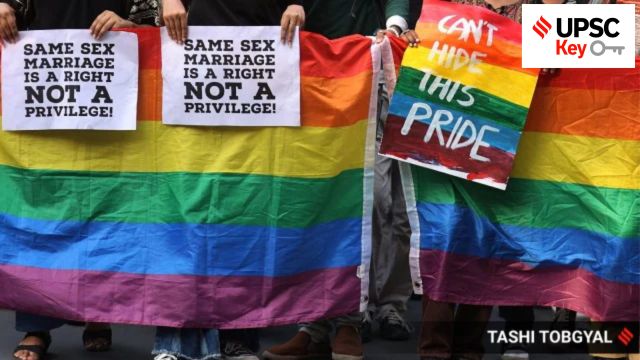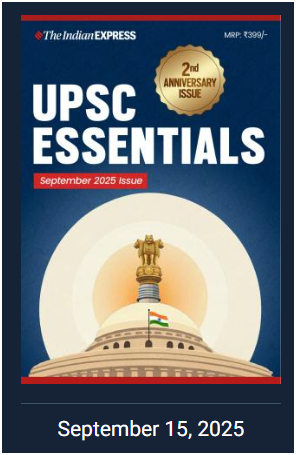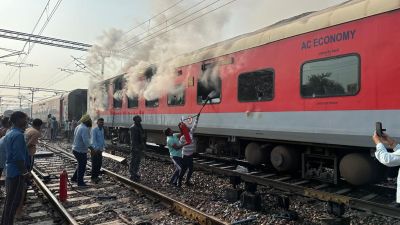Priya Kumari Shukla is a Senior Copy Editor in the Indian Express (digital). She contributes to the UPSC Section of Indian Express (digital) and started niche initiatives such as UPSC Key, UPSC Ethics Simplified, and The 360° UPSC Debate. The UPSC Key aims to assist students and aspirants in their preparation for the Civil Services and other competitive examinations. It provides valuable guidance on effective strategies for reading and comprehending newspaper content. The 360° UPSC Debate tackles a topic from all perspectives after sorting through various publications. The chosen framework for the discussion is structured in a manner that encompasses both the arguments in favour and against the topic, ensuring comprehensive coverage of many perspectives. Prior to her involvement with the Indian Express, she had affiliations with a non-governmental organisation (NGO) as well as several coaching and edutech enterprises. In her prior professional experience, she was responsible for creating and refining material in various domains, including article composition and voiceover video production. She has written in-house books on many subjects, including modern India, ancient Indian history, internal security, international relations, and the Indian economy. She has more than eight years of expertise in the field of content writing. Priya holds a Master's degree in Electronic Science from the University of Pune as well as an Executive Programme in Public Policy and Management (EPPPM) from the esteemed Indian Institute of Management Calcutta, widely recognised as one of the most prestigious business schools in India. She is also an alumni of Jamia Milia Islamia University Residential Coaching Academy (RCA). Priya has made diligent efforts to engage in research endeavours, acquiring the necessary skills to effectively examine and synthesise facts and empirical evidence prior to presenting their perspective. Priya demonstrates a strong passion for reading, particularly in the genres of classical Hindi, English, Maithili, and Marathi novels and novellas. Additionally, she possessed the distinction of being a cricket player at the national level. Qualification, Degrees / other achievements: Master's degree in Electronic Science from University of Pune and Executive Programme in Public Policy and Management (EPPPM) from Indian Institute of Management Calcutta ... Read More
UPSC Key: Same-Sex Marriage, genome sequencing and India and Taliban
Why data transmission system and gold counting error is relevant to the UPSC exam? What is the significance of topics such as challenges associated with a legally guaranteed MSP, Southern California wildfires 2025 and the Institution of Marriage, on both the preliminary and main exams? You can learn more by reading the Indian Express UPSC Key for January 10, 2025.
 UPSC Key January, 2025: Here's what you should be reading from the January 10, 2025 edition of The Indian Express
UPSC Key January, 2025: Here's what you should be reading from the January 10, 2025 edition of The Indian Express Important topics and their relevance in UPSC CSE exam for January 10, 2025. If you missed the January 9, 2025 UPSC CSE exam key from the Indian Express, read it here
FRONT PAGE
Grant visa to Afghan students, patients and businessmen, Taliban urge India
Syllabus:
Preliminary Examination: Current events of national and international importance.
Mains Examination: General Studies II: India and its neighbourhood- relations
What’s the ongoing story: Hours after India and Taliban-ruled Afghanistan held their first high-level meeting, the Taliban announced that they had urged Delhi to issue visas to Afghan businessmen, patients and students.
Key Points to Ponder:
• India and Taliban and Afghanistan-Connect the dots
• Significance of India’s recent talks with the Taliban-Know in detail
• “Realism, not ideology, drives India’s engagement with the Taliban”—Decode the statement
• Strategic importance of Afghanistan for India’s connectivity projects and trade routes—Know in detail
• How India’s engagement with the Taliban align with New Delhi’s “Act West” policy?
• How India can enhance its leverage in Afghanistan while addressing the challenges posed by the Taliban regime?
Key Takeaways:
• Hafiz Zia Ahmad, deputy spokesperson for the Afghanistan Foreign Ministry, in a series of posts on X, said the request for issue of visas was conveyed by acting Foreign Minister Amir Khan Muttaqi to Foreign Secretary Vikram Misri when they met in Dubai Wednesday.
• The issue of granting visas is complicated and a hard ask for mainly three reasons:
—The Indian government does not officially recognise the Taliban government;
—The Indian security and intelligence establishment has flagged security threat perceptions regarding visa seekers from Afghanistan;
—The Indian government does not have a functional visa section at the Indian embassy in Kabul or functional consulates in Afghanistan.
• To assuage Indian security concerns, Muttaqi and the Taliban delegation, sources said, assured the Indian side that there would be no threat from those who would travel to India.
• But this is a very tricky issue for the Indian government since it has been very strict in issuing visas to Afghans after the Taliban takeover of the country in August 2021.
Do You Know:
• Following the capture of Kabul by the Taliban and the collapse of the Ashraf Ghani-led Afghan government on August 15 that year, the Indian government decided, four days later, to cancel all physical visas issued earlier to Afghan nationals, who were yet to arrive in India.
• The Indian government introduced a new category of ‘e-Emergency X-Misc’ visa for Afghans who wished to travel to India. So, those Afghan nationals were advised to apply for an Indian visa on the e-Visa portal.
• Only those Afghan nationals who had the Electronic Travel Authorization (ETA) for e-Emergency X-Misc visa issued by the Bureau of Immigration – it comes under the jurisdiction of the Ministry of Home Affairs – were allowed to board India-bound flights.
• Currently, the Indian embassy in Kabul is run by a small technical team which manages the delivery of humanitarian assistance and maintains contacts with the Taliban regime. Running visa services would require more manpower – officials and staff – at the embassy. This scaling would signal a higher diplomatic strength and presence on ground, which could tantamount to political signalling of upgrading the Indian diplomatic presence.
Other Important Articles Covering the same topic:
UPSC Prelims Practice Question Covering similar theme:
1. The term “Acting West” in India’s foreign policy primarily implies:
(a) Strengthening ties with the Middle East and Afghanistan
(b) Establishing relations with the Western Hemisphere
(c) Focusing on Western Europe for economic partnerships
(d) Prioritizing South America in foreign relations
SC rejects review of its order that had said no to same-sex marriage
Syllabus:
Preliminary Examination: Current events of national and international importance
Main Examination: General Studies II: Structure, organization and functioning of the Executive and the Judiciary—Ministries and Departments of the Government; pressure groups and formal/informal associations and their role in the Polity.
What’s the ongoing story: The Supreme Court Thursday dismissed petitions seeking review of its October 17, 2023 ruling that had rejected the prayer to grant legal recognition to same-sex marriages.
Key Points to Ponder:
• What “institutional limitations” Supreme Court cited?
• What are the issues associated with the legalisation of same sex marriage in India?
• What is the Special Marriage Act (SMA), 1954?
• The legal recognition for same sex marriage is a little more complex-why?
• What is the Concept behind marriages in Indian Subcontinent or in the Indian Society?
• The Institution of Marriage-Why marriage is referred as an institution?
• What is the Supreme Court’s role in shaping LGBTQIA+ rights in India, with special reference to its recent stance on same-sex marriage?
• Examine the global trends in the legalisation of same-sex marriage.
• How can India learn from international experiences in balancing tradition with constitutional rights?
• What are the ethical dimensions of denying legal recognition to same-sex marriage?
Key Takeaways:
• A five-judge bench of Justices B R Gavai, Surya Kant, B V Nagarathna, P S Narasimha and Dipankar Datta, which considered the petitions in chamber, found no error apparent on the face of the record of the majority view authored by Justice (retired) S Ravindra Bhat in the 2023 ruling.
• Citing “institutional limitations”, a five-judge bench, comprising then Chief Justice of India D Y Chandrachud, Justices Sanjay Kishan Kaul, S Ravindra Bhat, Hima Kohli and P S Narasimha, in four separate judgements, had declined to strike down or tweak provisions of the Special Marriage Act, 1954 (SMA), saying there was “no unqualified right” to marriage, and a same-sex couple could not claim it as a fundamental right under the Constitution.
• Rejecting the prayer to grant legal recognition to same-sex marriage, the bench had left it to Parliament to change the law to validate such a union.
Do You Know:
• In the 2023 ruling, the then CJI Chandrachud and Justice (since retired) Kaul, who were part of the five-judge bench, spoke in favour of a civil union, but it ended up being the minority view. CJI Chandrachud said this right to civil union or right to enter into an abiding cohabitational relationship could be traced to Part III of the Constitution, and thus placed a positive obligation on the State to accord recognition to it.
• A five-judge Constitution Bench headed by Chief Justice of India (CJI) D Y Chandrachud on October 17, 2023 unanimously declined to recognise same-sex marriages. The Bench, also comprising Justices Sanjay Kishan Kaul, Ravindra Bhat, Hima Kohli, and P S Narasimha, in a 3-2 majority verdict, also declined to allow civil unions for non-heterosexual couples.
• A ‘civil union’ refers to the legal status that allows same-sex couples specific rights and responsibilities that are normally conferred upon married couples. Although a civil union resembles a marriage, it does not have the same recognition in personal law as marriage.
Other Important Articles Covering the same topic:
📍Supreme Court says no to same-sex marriage: All you need to know about the top court’s verdict
UPSC Prelims Practice Question Covering similar theme:
2. The Supreme Court of India decriminalized homosexuality in the landmark judgment of which case?
(a) Kesavananda Bharati v. State of Kerala
(b) Navtej Singh Johar v. Union of India
(c) S. P. Gupta v. Union of India
(d) Vishaka v. State of Rajasthan
GOVT & POLITICS
Genome data of 10k Indians available for research, PM says milestone
Syllabus:
Preliminary Examination: General Science and Current events of national and international importance.
Mains Examination: General Studies III: Awareness in the fields of IT, Space, Computers, robotics, nanotechnology, bio-technology.
What’s the ongoing story: The genome sequencing data of 10,000 Indians, sequenced from 99 distinct populations, will now be available for researchers to develop medicines tailored to the local population.
Key Points to Ponder:
• What is genome sequencing?
• What do you understand by the term ‘Genome’?
• How Genome and Gene differ from each other?
• What is the primary goal of the Genome India Project?
• How Genome India Project is significant in understanding India’s genetic diversity?
• What are the ethical and legal implications of making genome data available for research?
• What are the potential applications of genomic research in India?
Key Takeaways:
• Launching the mammoth dataset — 8 petabytes of data stored at the Indian Biological Data Centre — Prime Minister Narendra Modi Friday hailed the “milestone” in biotechnology research.
• He said in a filmed address at the Genomics Data Conclave in New Delhi: “The Genome India project is an important step in the country’s biotech revolution. With this project, we will create a diverse genetic resource… India is not only diverse in geography, food, and culture, it is also diverse in genetic make-up. So, knowing the genetic identity of the country is important.”
• Union Science Minister Jitendra Singh said the project will boost the biopharma sector and ensure that Indian diseases are treated with Indian remedies.
• Researchers wishing to utilise the data will have to respond to a call for proposals and collaborate with the department. The research will be funded by the government.
• Approved by the government in 2020, the Genome India project looks to create a comprehensive catalogue of genetic variations found in the Indian population.
Do You Know:
• A genome, simply put, is all the genetic matter in an organism. It is defined as “an organism’s complete set of DNA, including all of its genes. Each genome contains all of the information needed to build and maintain that organism. In humans, a copy of the entire genome — more than 3 billion DNA base pairs — is contained in all cells that have a nucleus”.
• Genome India, a national project funded by the Department of Biotechnology, Government of India, was launched in January 2020.Its ambitious goal is to sequence 10,000 genomes from healthy Indian individuals spanning the length and breadth of the country.
• The primary aim of Genome India is to construct a comprehensive catalogue of genetic variations for India’s population that will better capture our unique diversity. This initiative is not just about decoding our genes; it is about creating a detailed reference that encapsulates the Indian population’s genetic makeup and enables a deeper understanding of its diversity.
• The entire dataset — which adds up to 8 petabytes of data — will be stored at the Indian Biological Data Centre (IBDC) and will be made available as a digital public good or research. Inaugurated in 2022, the IBDC is the country’s only databank. Prior to that Indian researchers had to host their biological datasets on American or European servers.
Other Important Articles Covering the same topic:
📍Explained: The Genome India project, aimed at creating a genetic map of the country
Previous year UPSC Prelims Question Covering similar theme:
3. With reference to agriculture in India, how can the technique of ‘genome sequencing’, often seen in the news, be used in the immediate future? (2017)
1. Genome sequencing can be used to identify genetic markers for disease resistance and drought tolerance in various crop plants.
2. This technique helps in reducing the time required to develop new varieties of crop plants.
3. It can be used to decipher the host-pathogen relationships in crops.
Select the correct answer using the code given below:
(a) 1 only
(b) 2 and 3 only
(c) 1 and 3 only
(d) 1, 2 and 3
THE IDEAS PAGE
Syllabus:
Preliminary Examination: Economic and Social Development
Main Examination: General Studies III: Issues related to direct and indirect farm subsidies and minimum support prices
What’s the ongoing story: Harish Damodaran writes: It is a strategic imperative and in enlightened consumer self-interest to make our farmers farm today, tomorrow and beyond. The world cannot feed us; only we can
Key Points to Ponder:
• The price security for farmers—What it should be exactly?
• Do You believe that the price security for farmers will ensure sustainable agricultural practices?
• What are the challenges associated with implementing Minimum Support Price (MSP) in India?
• Can you suggest alternatives to ensure price security for farmers?
• ‘PM-KISAN and Bhavantar Bhugtan Yojana addresses the issue of agricultural price volatility’-what is your opinion?
Key Takeaways:
Harish Damodaran writes:
• Should there be a minimum support price (MSP) guarantee, legal or otherwise, for crops produced by farmers? Two decades or less from now, we wouldn’t be debating this at all!
• The reason is simple: Agriculture is seeing a haemorrhaging of the best lands as well as human resources.
• The most fertile farmlands — be it on both sides of the Grand Trunk Road, the Ganga-Yamuna Doab riverine plains or the Krishna-Godavari, Cauvery and Mahanadi alluvial delta basins — are getting diverted for real estate development, if not for building infrastructure, factories and smart cities.
• India officially has 146.5 million “operational holdings” (2015-16 Agriculture Census) and 105-115 million beneficiaries under the PM-Kisan Samman Nidhi income support scheme. But the actual “serious” farmer population — households deriving at least half of their income from agriculture — may not be more than 40 million.
• The challenge before Indian agriculture isn’t just one of feeding 1.7 billion mouths by the early-2060s. It’s about retaining the best available agricultural lands and human talent in farming.
• “Legal MSP” is the least we can give to our farmers, who one must assume to be as rational and risk-averse as any businessmen. The way to do it is by paying the price difference when a crop is sold below its government-declared MSP.
• A price deficiency payments (PDP) system will spur formalisation and digitisation of the farm produce trade, which is still largely cash-based. Farmers once aware of PDP will start demanding receipts from buyers, detailing both the quantity and price at which their crop has been sold.
• PDP will also incentivise states to set up APMC mandis or even electronic trading platforms outside the physical market yards, where farmers can sell their produce.
Do You Know:
Harish Damodaran in the article “The question of MSP” says, there are two conventional ways.
• The first is to force buyers to pay MSP. Sugar mills are required, by law, to pay cane growers a “fair and remunerative” or “state advised” price within 14 days of purchase. But this approach risks implementation hurdles (recurrent cane payment arrears are proof), or worse, the private trade choosing to not buy at all.
• The second is for government agencies to buy the entire marketable produce of farmers offered at MSP. That is unsustainable, both physically and fiscally.
• But there’s a third option: price deficiency payments (PDP). It entails the government not physically purchasing or stocking any crop, and simply paying farmers the difference between the market price and MSP, if the former is lower. Such payment would be on the quantity of crop they sell to the private trade.
• PDP was tried out first in Madhya Pradesh through a Bhavantar Bhugtan Yojana.
• Under this scheme, the market price for a crop was its average modal (most-quoted) rate in the Agricultural Produce Market Committee (APMC) mandis of Madhya Pradesh as well as two other growing states during the particular month of sale.
The price difference vis-à-vis the MSP was payable on the actual quantity sold by the farmer, backed by an “anubandh patra” (sale agreement with trader), “tol parchi” (weighment slip), and “bhugtan patra” (payment letter signed by both parties).
The Madhya Pradesh scheme was implemented during the 2017-18 kharif (post-monsoon) season for eight crops: urad (black gram), soyabean, maize, arhar (pigeon pea), moong (green gram), groundnut, sesame, and nigerseed. But despite 21 lakh-odd farmers registering and payments of about Rs 1,952 crore being made, the scheme couldn’t be continued for lack of Central support.
• Haryana’s PDP scheme, called Bhavantar Bharpai Yojana (BBY), is being implemented mainly in bajra (pearl millet), mustard, and sunflower seed, although technically is also covers groundnut, chana (chickpea), moong, and 16 vegetable and 3 fruit crops.
• Both Madhya Pradesh and Haryana have demonstrated the feasibility of delivering MSP to farmers at least in some crops other than rice, wheat, and sugarcane. One reason they have been able to do this is because of the already-created APMC mandi infrastructure and systems for farmer registration in these states. This makes it possible to record each transaction — what quantity of any crop a farmer has sold at a certain price — and to pay the difference vis-à-vis the MSP based on that.
Other Important Articles Covering the same topic:
UPSC Prelims Practice Question Covering similar theme:
4. Who determines the Minimum Support Price (MSP) in India?
(a) Ministry of Agriculture and Farmers Welfare
(b) Food Corporation of India (FCI)
(c) Commission for Agricultural Costs and Prices (CACP)
(d) Reserve Bank of India (RBI)
Syllabus:
Preliminary Examination: Economic and Social Development
Main Examination: General Studies III: Issues related to direct and indirect farm subsidies and minimum support prices
What’s the ongoing story: Ashok Gulati writes: India is the only country that implicitly taxes its agriculture by suppressing market prices. What Indian farmers need is freer markets.
Key Points to Ponder:
• MSP (minimum support price) and effectiveness of MSP implementation-discuss
• Discuss the arguments against the legalisation of Minimum Support Price (MSP).
• “Legalising MSP may lead to fiscal strain and market distortions.” Critically examine this statement with reference to India’s agricultural policies.
• Highlight the challenges associated with a legally guaranteed MSP.
• What is the role of MSP as a welfare measure for farmers. Should it be replaced by direct income support schemes like PM-KISAN? Provide reasons.
Key Takeaways:
Ashok Gulati writes:
• In a market economy, the price of any product is decided by the forces of demand and supply.
• Some activists suggest price deficiency payments. Several cost estimates of such a scheme are being floated. The problem with such a scheme is that if MSP is declared legal, then there would be no real market price below MSP. Then the government becomes the open-ended buyer of all commodities for which MSPs are declared, which are 23 as on day.
• If one argues that MSP is not legal, and agri-markets do exist and price discovery is possible, but farmers need to be compensated for the difference between MSP and lower market prices as price deficiency payments to farmers, we are talking about a different policy — making MSP more of an income instrument.
• The downside of such a policy is that the moment traders know that the government will compensate the farmers by the difference in MSP and market prices, they are likely to push market prices even lower, and there is a high probability that farmers and traders will collude in showing market prices much lower than the MSP.
• It may be worth noting that the 23 MSP crops constitute roughly 30 per cent of the value of agriculture. Within these 23 crops, MSP is properly implemented in the case of rice and wheat, that too in a few states. The Centre’s latest Situation Assessment Survey revealed that not more than 10 per cent of farmers sold their produce at MSP.
• Amongst the G20 countries, as per OECD, India is the only country that has negative Producer Support Estimates (PSEs), meaning that India implicitly taxes its agriculture by suppressing market prices. What Indian farmers need is freer markets, building of agri-value chains — like the AMUL model in milk — where farmers can get 75 to 80 per cent of what consumer pays. Making MSP legal will be going backwards, which is not in line with the liberalisation of the economy.
Do You Know:
• The concept of Minimum Support Price (MSPs) was first proposed throughout the 1960s. The government declares minimum support prices for a total of 23 crops throughout each farming season.
• The Minimum Support Price (MSP) for a commodity refers to the price at which the government is obligated to purchase the produce from farmers in the event that the market price falls below this threshold.
• “It is only a government policy that is part of administrative decision-making. The government declares MSPs for crops, but there’s no law mandating their implementation,” explained Abhijit Sen, former Planning Commission member and chairman of the Commission for Agricultural Costs & Prices (CACP).
• The Centre currently fixes MSPs for 23 farm commodities — 7 cereals (paddy, wheat, maize, bajra, jowar, ragi and barley), 5 pulses (chana, arhar/tur, urad, moong and masur), 7 oilseeds (rapeseed-mustard, groundnut, soyabean, sunflower, sesamum, safflower and nigerseed) and 4 commercial crops (cotton, sugarcane, copra and raw jute) — based on the CACP’s recommendations.
• But the CACP itself is not any statutory body set up through an Act of Parliament. This, despite its coming to existence in 1965 and MSPs being announced since the time of the Green Revolution, starting with wheat in 1966-67. The CACP, as its website states, is just “an attached office of the Ministry of Agriculture and Farmers Welfare, Government of India”. It can recommend MSPs, but the decision on fixing (or even not fixing) and enforcement rests finally with the government.
• The only crop where MSP payment has some statutory element is sugarcane. This is due to its pricing being governed by the Sugarcane (Control) Order, 1966 issued under the Essential Commodities Act. That order, in turn, provides for the fixation of a ‘fair and remunerative price’ (FRP) for cane during every sugar year (October-September).
Other Important Articles Covering the same topic:
📍Explained: What is minimum support price (MSP), and how is it fixed?
UPSC Prelims Practice Question Covering similar theme:
5. In India, which of the following can be considered as public investment in agriculture? (UPSC GS1, 2020)
(1) Fixing Minimum Support Price for agricultural produce of all crops
(2) Computerization of Primary Agricultural Credit Societies
(3) Social Capital development
(4) Free electricity supply to farmers
(5) Waiver of agricultural loans by the banking system
(6) Setting up of cold storage facilities by the governments.
Select the correct answer using the code given below:
(a) 1, 2 and 5 only
(b) 1, 3, 4 and 5 only
(c) 2, 3 and 6 only
(d) 1, 2, 3, 4, 5 and 6
THE WORLD
Hollywood hills burn in worst LA fires, more than a lakh ordered to evacuate
Syllabus:
Preliminary Examination: Current events of national and international importance.
Main Examination:
• General Studies III: Conservation, environmental pollution and degradation, environmental impact assessment.
• General Studies III: Disaster and disaster management.
What’s the ongoing story: A fire broke out near Sunswept Drive and Vanetta Place in Studio City late Wednesday night, damaging several homes as firefighters rushed to contain the flames.
Key Points to Ponder:
• Why is Los Angeles burning at this time?
• What caused the devastating California wildfires?
• Discuss the geographical and climatic factors that make California prone to wildfires.
• Analyze the impact of wildfires on biodiversity, ecosystems, and local communities.
• Highlight the governance challenges in managing wildfires in urban and forested areas.
• What lessons can India learn from California’s wildfire management strategies?
• “Balancing economic development with environmental conservation is essential to mitigate wildfire risks.” Analyse this statement with reference to urban expansion and forest management policies.
Key Takeaways:
• The blaze, named the Sunswept Fire, began as a small brush fire before rapidly spreading to nearby homes, igniting spot fires that caused additional damage. While no injuries were reported, officials said the full extent of the damage had yet to be assessed.
• The Sunswept Fire is one of several wildfires sweeping across Los Angeles County, part of a devastating series of blazes that have already claimed at least five lives and caused hundreds of injuries.
• The National Weather Service has issued red flag warnings for parts of Southern California, signaling extreme fire danger due to a combination of high temperatures, low humidity, and gusty winds.
• While California is no stranger to wildfires, the current flare-up is very big and very fast. More remarkably, it is in winter, traditionally not the wildfire season.
Do You Know:
According to the Associated Press:
• Although lightning is typically the leading cause of wildfires in the U.S., as per the National Fire Protection Association, investigators quickly dismissed it as a factor. There were no lightning incidents reported in the Palisades area or near the Eaton fire in eastern Los Angeles County, which has also destroyed hundreds of homes.
• The next two most common causes: fires intentionally set, and those sparked by utility lines.
• The 2017 Thomas Fire, one of the largest fires in state history, was sparked by Southern California Edison power lines that came into contact during high wind, investigators determined. The blaze killed two people and charred more than 440 square miles (1,140 square kilometers), according to the investigation headed by the Ventura County Fire Department.
• So far no such reports for the current fires have been posted to the CPUC website that tracks such filings.
• While lightning, arson and utility lines are the most common causes, debris burning and fireworks are also common causes.
• But fires are incited by myriad sources, including accidents.
Other Important Articles Covering the same topic:
📍Southern California wildfires 2025 explained: Why the blaze in winter, why it is so bad
UPSC Prelims Practice Question Covering similar theme:
6. Which climatic phenomenon is often linked to the intensification of wildfires?
(a) El Niño-Southern Oscillation (ENSO)
(b) La Niña
(c) Polar vortex
(d) Indian Ocean Dipole
ECONOMY
Migration of data transmission system led to gold counting error, says govt
Syllabus:
Preliminary Examination: Current events of national and international importance.
Mains Examination: General Studies III: Indian Economy and issues relating to planning, mobilization, of resources, growth, development and employment.
What’s the ongoing story: The commerce and industry ministry on Thursday said that the overestimation of gold import figures between April to November was a result of an error that took place due to migration of data transmission mechanisms and subsequent double counting of imports coming into special economic zones (considered foreign territory) and clearance to domestic zones.
Key Points to Ponder:
• What is data migration system?
• How migration of data transmission system led to gold counting error?
• Discuss the implications of errors in data transmission systems for governance and policy-making in India.
• What is the role of government agencies like the CBIC in ensuring accurate trade data reporting?
• “Accurate trade data is critical for effective decision-making in a globalized economy.” Critically analyse this statement in light of the recent gold counting error.
Key Takeaways:
• The explanation comes a day after the ministry revised the gold import figures for November lower by $5 billion to $9.9 billion from $14.8 billion narrowing the overall goods trade deficit for the month to $33 billion from $38 billion.
• “It was observed that due to migration of data transmission mechanism from Special Economic Zone (SEZ) to Indian Customs Electronic Gateway (ICEGATE), figures of precious metals needed revision as it was noticed as the system was calculating both imports into SEZ and subsequent clearance into Domestic Tariff Area (DTA) as separate transactions after the migration,” the ministry said.
• The ministry said that DGCI&S receives trade data from over 500 locations and about 2.5 lakh transactions every day from different sea ports, land ports, airport and inland container depots and trade data from more than 100 SEZs was earlier captured by SEZ Online System and EXIM data for all other ports was captured by ICEGATE system.
• “The principal commodity level data, which have been uploaded recently at DGCIS Data Dissemination Portal, incorporates the first phase of reconciliations made till date. Revision has been done for trade figures from April 2024 to November 2024, which are made public in compliance to the regular publication cycle maintained as per international standard data dissemination norms,” the ministry said.
• The revised data can be accessed through the Data Dissemination Portal of DGCIS. A committee has been formed with stakeholders from DGCIS, DG Systems (CBIC) and SEZs for creation of a robust mechanism for publishing consistent data, the ministry added.
Do You Know:
• The ICEGATE is the national portal of Indian Customs of the Central Board of Indirect Taxes and Customs (CBIC) that provides e-filing services to trade, cargo carriers and other trading partners electronically.
• The double counting which occurred on account of migration to ICEGATE has now been largely rectified, but the migration is still underway.
• Earlier all imports and exports by SEZs were recorded on an online system that was managed by NSDL and then from May it was decided to migrate this data to Indian Customs Electronic Gateway (ICEGATE) system for streamlined reporting.
• Due to the double counting the imports of the yellow metal was overstated by as much as $ 11.73 billion. Gold imports in April-November now stand at $ 37.35 billion from $ 49.08 reported earlier. The deficit for April-November in goods trade would now come down to $ 190.69 billion from $ 202.42 billion reported earlier.
• A similar migration to a newer software in 2011 led to overstating of export numbers by $ 9 billion. The numbers were revised a month later.
• India’s trade data compilation process starts with exporters and importers filing Shipping Bills (for exports) and Bills of Entry (for imports) through the Electronic Data Interchange (EDI) system at Customs. All the data comes to the server of ICEGATE. The data is verified and then transmitted to the Directorate General of Commercial Intelligence and Statistics (DGCIS) in real-time for compilation.
Other Important Articles Covering the same topic:
📍Double counting error: Official gold import figures for Nov revised down by $5 billion
UPSC Prelims Practice Question Covering similar theme:
7. What was the primary cause of the gold counting error as mentioned in the article?
(a) Human error during data entry
(b) Technical glitches during migration of the data transmission system
(c) Incorrect gold valuation methods
(d) Discrepancies in customs duties
|
PRELIMS ANSWER KEY |
| 1. (a) 2. (b) 3. (d) 4. (c) 5. (c) 6. (a) 7. (b) |
For any queries and feedback, contact priya.shukla@indianexpress.com
Subscribe to our UPSC newsletter. Stay updated with the latest UPSC articles by joining our Telegram channel – IndianExpress UPSC Hub, and follow us on Instagram and X.
UPSC Magazine

Read UPSC Magazine






- 01
- 02
- 03
- 04
- 05


























